#SAP Risk Management Tool
Explore tagged Tumblr posts
Text
SAP Risk Management | SAP GRC RM | Governance Risk & Compliance | ToggleNow
At ToggleNow, we understand that exhaustive lists of risks can overwhelm and often become irrelevant, leading to inefficiencies. Our approach emphasizes focusing on value and core business activities in risk management. We believe that prioritizing risks impacting value and business performance is crucial, even if it means concentrating on a smaller yet more impactful segment of the business.

Our commitment lies in streamlining risk management efforts by leveraging SAP Risk Management. This comprehensive solution fosters collaboration and ensures consistency throughout your organization. We empower businesses to navigate risks effectively while concentrating efforts where risk managers can make the most significant contributions.
Read more: https://togglenow.com/services/sap-risk-management/
#Audit Management System#SAP Risk Management#SAP Risk Management Tool#SAP Risk Management services#SAP Enterprise Risk Management#SAP Risk Management Software#SAP Governance Risk and Compliance#SAP GRC Solutions Provider
0 notes
Text
When to Redesign SAP Roles: During ECC or Post-Migration to S/4HANA or Rise with SAP
Migrating to SAP S/4HANA or adopting RISE/GROW with SAP is a strategic milestone for organizations aiming to modernize their ERP landscape. However, one critical consideration often overlooked during these transitions is the redesign of SAP roles. The timing of this redesign can significantly influence the success of the migration and the overall efficiency. Should you redesign roles during the ECC phase or wait until after the migration to S/4HANA? This blog explores the key factors driving this decision and introduces the S.M.A.R.T framework—a modern approach to SAP role redesign that ensures compliance, efficiency, and business alignment.
Understanding the Need for Role Redesign
SAP roles are pivotal in defining user access, ensuring compliance, and maintaining operational efficiency. Over time, roles in ECC systems often become bloated with unused authorizations or misaligned with current business needs. This can lead to:
Compliance Risks: Excessive authorizations increase the risk of segregation of duties (SoD) violations.
Migration Complications: Legacy roles with redundancies can complicate the migration process to S/4HANA.
Operational Costs: Since the licensing model is based on assignment and not by usage in S/4HANA and RISE, you may need to procure more licenses than required.
A role redesign ensures clean, streamlined, and compliant access structures, setting the stage for a smooth transition and efficient system post-migration.
ls.ECC vs. S/4HANA: When to Redesign Roles?
Aspect
Redesign During ECC
Redesign Post-Migration to S/4HANA
Compliance
Proactively addresses SoD conflicts and access risks.
Allows compliance alignment with new functionalities post-migration.
Migration Complexity
Simplifies migration with clean and optimized roles.
Reduces redundant effort, focusing only on relevant roles in the new system
Alignment with New Features
May require rework later to incorporate S/4HANA-specific functionalities.
Ensures roles are tailored to new modules, Fiori apps, and processes.
Timeline and Resources
Increases project timelines due to pre-migration workload.
Defers redesign efforts, potentially affecting initial system efficiency.
Business Process Analysis
Limited to existing ECC processes, with potential misalignment after migration.
Better aligned with current and optimized business processes in S/4HANA.
Redesigning SAP Roles with RISE with SAP
If you are moving to RISE with SAP, it is advisable to conduct a complete role redesign during the ECC phase. Once the migration is complete, perform a retrofit to align roles with the cloud-specific requirements introduced by RISE. This approach addresses the unique security, integration, and scalability considerations of a cloud-oriented transformation. You might have many questions at this juncture – What is the best approach? Which tools must be considered? Are there any accelerators that can be used? Can we use stock ready/ready to deploy role structures?
Challenges with Stock Ready Rulesets
Many system integrators offer pre-packaged or stock-ready rulesets as part of their role redesign services. While these rulesets might appear to save time and effort, they often come with significant challenges, making them unsuitable for many businesses. Here’s why the stock-ready approach is not recommended:
Lack of Customization: Stock-ready rulesets are designed to be generic and may not align with the specific needs of your industry or business processes. This can result in inadequate or excessive authorizations.
Compliance Risks: These pre-packaged rulesets may not fully address industry-specific compliance requirements, leaving gaps that could lead to audit findings or regulatory penalties.
Misalignment with Business Processes: Every organization has unique workflows and processes. Stock-ready rulesets may not account for these nuances, leading to inefficiencies and user frustrations.
Post-Implementation Challenges: Organizations often need to spend additional time and resources customizing these rulesets post-implementation, negating the perceived benefits of a quick deployment.
Instead of relying on stock-ready rulesets, organizations should invest in a tailored role redesign approach. This ensures that roles are aligned with specific business processes, compliance requirements, and future scalability needs, delivering long-term value and efficiency. This is where S.M.A.R.T approach/framework can be a life saver.
The S.M.A.R.T Role Redesign Framework
At ToggleNow, we leverage the S.M.A.R.T framework for SAP role redesign. This approach ensures that roles are:
Simplified: Designed to reduce complexity while maintaining operational effectiveness.
Mitigated for Risks: Focused on eliminating SoD conflicts and maintaining regulatory compliance.
Aligned with Business Tasks: Task-based roles ensure that access permissions directly support specific workflows.
Responsive to Change: Built to adapt seamlessly to future business or technical changes.
Transparent and Optimized: Designed with a focus on license optimization to eliminate unnecessary expenditures.
This framework delivers roles that are not only secure but also cost-effective and easy to manage
ToggleNow Advantage
ToggleNow brings a unique value proposition to SAP role redesign initiatives, ensuring a seamless and efficient process tailored to your business needs. Here’s why we stand out:
Customized Solutions: Unlike stock-ready rulesets, ToggleNow develops tailored role designs aligned with your specific business processes, compliance requirements, and industry standards.
Deep Expertise: With extensive experience in SAP role redesign, ToggleNow combines technical proficiency with a deep understanding of regulatory compliance and security best practices.
Innovative Tools:ToggleNow leverages proprietary tools such as Verity, Optimus and accelerators such as xPedite to streamline role redesign, risk analysis, and validation, ensuring faster project delivery.
Focus on Scalability:Our approach ensures that the roles we design are not only compliant and efficient but also scalable, adapting to your future business growth.
Proven Track Record:Trusted by leading organizations, ToggleNow has successfully delivered role redesign projects across diverse industries, enabling smoother migrations and enhanced system performance.
By partnering with ToggleNow, organizations can confidently navigate their SAP transitions, optimizing roles to drive operational excellence and long-term success.
Conclusion
The decision to redesign SAP roles during ECC or post-migration to S/4HANA or RISE with SAP depends on your organization’s priorities, resources, and timeline. Redesigning during ECC can simplify the migration process, while post-migration redesign allows alignment with new functionalities. For RISE with SAP, role redesign becomes even more critical to address cloud-specific requirements.
Moreover, organizations should avoid the pitfalls of stock-ready rulesets and opt for a customized approach that aligns with their unique requirements. By investing in a well-planned redesign, organizations can unlock the full potential of SAP S/4HANA or RISE with SAP, driving operational excellence and business growth.
Read more: https://togglenow.com/blog/redesign-sap-roles-ecc-or-s-4hana/

#SAP Risk Management#SAP access risk analysis tool#SAP GRC access control solution#SAP segregation of duties automation#SoD risk analysis for SAP
0 notes
Text
Tools of The Trade || Harlequin Cleavers


My new lead is the reaper, and my anger is my scythe- together we will make this right.
Ever the tinkerer driven by opportunity to improve his ability to kill The Pig's most notable handiwork is surely the very cleaver that hangs at his waist- and the waist of all his children.
While the original was little more than a rusty butcher's tool of necessity, the present iteration and the version given to his children is a far more refined piece of kit, intended to allow those who wield them more flexibility with their use- and to make Pig and Sow's bloodline all the more formidable for it.
Heavy and broad, the cleaver's most basic function remains the one it does best, it is a splitting weapon, intended to separate large limbs from bodies, and divide meat into more manageable chunks. But beneath the hood, these rusted gatherings of blood-soaked metal hide a far more refined mechanical function. Capable of being loaded near the handle with glass vials wrapped at the top and bottom in ornate copper filigrees, the hand guard can be wrenched back on hidden hinges to expose something akin to a firearm's chamber for bullets and locked back into place once filled with three ampules- though these vials are not capable of anything dangerous while empty.
Intended to harvest raw magic from bodies they impact, cut, or even make glancing contact with, the secondary function of the Harlequin Cleavers has always been as a tool for harvesting. Draining the power from within a stumbling, dying spirit over the course of a Godfall, sapping the fight from a potential victim unlucky enough to fall into the ire of the mad clown, or in more dire cases, pulling one's own magic from their flesh for safe keeping, the three-round installment beneath the handle capably fills and then swaps containers to keep the hunt going with less need for a reload- and thus any risk of losing what they're pursuing.
Once filled, these vials are nearly priceless (though raw magic in my lore will have to be touched on another time, note that many dragons aren't inherently magical or aren't magical permanently- there's a market for magic harvested secondhand- and a wider one for that pulled from "Gods" of the gaps.) and incredibly volatile. required to be unloaded and replaced with new, empty containers and the full ones stored in specially made, blast-proof bandoliers. But a full vial has its uses left inside the weapon- a twist of the handle punctures the most recently filled vial, imbuing whatever magic was contained within into the cutting and sawing edges of the cleavers themselves.
Typically considered a "last ditch effort" in Pig's eyes, doing so runs the risk of permanently damaging the cleaver itself- raw fire magic ripping through the internal body could damage metal, shadow's sticking, cloying blackness could be rather problematic to fight through when the thing spreading it is being swung at high speeds- but in the face of death, Pig and Sow have taught their children one thing:
Make the reaper fight for his meal.
30 notes
·
View notes
Text
Stackpack Secures $6.3M to Reinvent Vendor Management in an AI-Driven Business Landscape
New Post has been published on https://thedigitalinsider.com/stackpack-secures-6-3m-to-reinvent-vendor-management-in-an-ai-driven-business-landscape/
Stackpack Secures $6.3M to Reinvent Vendor Management in an AI-Driven Business Landscape


In a world where third-party tools, services, and contractors form the operational backbone of modern companies, Stackpack has raised $6.3 million to bring order to the growing complexity.
Led by Freestyle Capital, the funding round includes support from Elefund, Upside Partnership, Nomad Ventures, Layout Ventures, MSIV Fund, and strategic angels from Intuit, Workday, Affirm, Snapdocs, and xAI.
The funding supports Stackpack’s mission to redefine how businesses manage their expanding vendor networks—an increasingly vital task as organizations now juggle hundreds or even thousands of external partners and platforms.
Turning Chaos into Control
Founded in 2023 by Sara Wyman, formerly of Etsy and Affirm, Stackpack was built to solve a problem she knew too well: modern companies are powered by vendors, yet most still track them with outdated methods—spreadsheets, scattered documents, and guesswork. With SaaS stacks ballooning and AI tools proliferating, unmanaged vendors become silent liabilities.
“Companies call themselves ‘people-first,’ but in reality, they’re becoming ‘vendor-first,’” said Wyman. “There are often 6x more vendors than employees. Yet there’s no system of record to manage that shift—until now.”
Stackpack gives finance and IT teams a unified, AI-powered dashboard that provides real-time visibility into vendor contracts, spend, renewals, and compliance risks. The platform automatically extracts key contract terms like auto-renewal clauses, flags overlapping subscriptions, and even predicts upcoming renewals buried deep in PDFs.
AI That Works Like a Virtual Vendor Manager
Stackpack’s Behavioral AI Engine acts as an intelligent assistant, surfacing hidden cost-saving opportunities, compliance risks, and critical dates. It not only identifies inefficiencies—it takes action, issuing alerts, initiating workflows, and providing recommendations across the vendor lifecycle.
For instance:
Renewal alerts prevent surprise charges.
Spend tracking identifies underused or duplicate tools.
Contract intelligence extracts legal and pricing terms from uploads or integrations with tools like Google Drive.
Approval workflows streamline onboarding and procurement.
This brings the kind of automation once reserved for enterprise procurement platforms like Coupa or SAP to startups and mid-sized businesses—at a fraction of the cost.
A Timely Solution for a Growing Problem
Vendor management has become a boardroom issue. As more companies shift budgets from headcount to outsourced services, compliance and financial oversight have become harder to maintain. Stackpack’s early traction is proof of demand: just months after launch, it’s managing over 10,500 vendors and $510 million in spend across more than 50 customers, including Every Man Jack, Rho, Density, HouseRx, Fexa, and ZeroEyes.
“The CFO is the one left holding the bag when things go wrong,” said Brandon Lee, Accounting Manager at BizzyCar. “Stackpack means we don’t have to cross our fingers every quarter.”
Beyond Visibility: Enabling Smarter Vendor Decisions
Alongside its core platform, Stackpack is launching Requests & Approvals, a lightweight tool to simplify vendor onboarding and purchasing decisions—currently in beta. The feature is already attracting customers looking for faster, more agile alternatives to traditional procurement systems.
With a long-term vision to help companies not only manage but discover and evaluate vendors more strategically, Stackpack is laying the groundwork for a smarter, interconnected vendor ecosystem.
“Every vendor decision carries legal, financial, and security consequences,” said Dave Samuel, General Partner at Freestyle Capital. “Stackpack is building the intelligent infrastructure to manage these relationships proactively.”
The Future of Vendor Operations
As third-party ecosystems grow in size and complexity, Stackpack aims to transform vendor operations from a liability into a competitive advantage. Its AI-powered approach gives companies a modern operating system for vendor management—one that’s scalable, proactive, and deeply integrated into finance and operations.
“This isn’t just about cost control—it’s about running a smarter company,” said Wyman. “Managing your vendors should be as strategic as managing your talent. We’re giving companies the tools to make that possible.”
With fresh funding and a rapidly expanding customer base, Stackpack is poised to become the new standard for how modern businesses manage the partners powering their growth.
#2023#accounting#agile#ai#ai tools#AI-powered#alerts#amp#approach#automation#Behavioral AI#budgets#Building#Business#CFO#chaos#Companies#complexity#compliance#dashboard#dates#documents#EARLY#Ecosystems#employees#engine#enterprise#finance#financial#form
2 notes
·
View notes
Text
Why Infor SyteLine ERP Is Ideal for Mid-Market Manufacturers & Service Providers

When electronics and other mid-market manufacturers want their ERP system to enable growth and create a new competitive advantage, they rely upon Infor Infor SyteLine, also known as CloudSuite Industrial (CSI).
When service and rental equipment providers want their ERP system to enable their growth into world-class service organizations and empower field technicians with data at their fingertips, they also rely upon Infor Infor SyteLine CSI.
We’ve all heard the horror stories of failed ERP implementations so, when manufacturers and service providers want SyteLine ERP successfully implemented—and guaranteed—they rely upon Bridging Business Technology Solutions (BBTS).
An ERP Ideal for Manufacturers
Infor SyteLine is the primary ERP we support because it’s ideal for use by discrete and process manufacturers, especially electronics manufacturers. We also guarantee the success of your Infor SyteLine implementation whether you’re commissioning an ERP system for the first time or replacing your current system, so you can cross the risk of a failed implementation off your list of worries.
SyteLine also can be customized to recognize customer-owned inventory and allocate it only to that customer so you don’t have a unique part number for the same part used by multiple customers. You can also reserve stock for specific products of the same customer or reserve any part in your inventory for a specific order until the order is released.
SyteLine delivers the same type of functionality as SAP and Oracle for a fraction of the cost and headache of implementing a tier 1 ERP system.
An ERP Ideal for Service Providers
Infor SyteLine is the primary ERP we support because it’s a perfect fit for service providers, especially those who rent equipment. We also guarantee the success of your Infor SyteLine implementation. So, whether you’re commissioning an ERP system for the first time or replacing your current system, you don’t have to worry about the disruption of a failed implementation.
Among the biggest benefits of SyteLine for service providers is no longer having to enter data multiple times into disparate systems. Working with common data means that everyone works from the same real-time information, which:
Empowers your service technicians to complete more service orders
Enables your employees to spend more time building relationships with customers
Gives your managers the tools to analyze data and find strategic growth opportunities
SyteLine delivers the same type of functionality as SAP and Oracle for a fraction of the cost and none of the headaches associated with implementing a tier 1 ERP system.
Successful Implementations, Guaranteed
The BBTS team has implemented SyteLine successfully over 165 times since 2013 with a proven ERP implementation process that begins with improving inventory control, planning and forecasting, financial close, and other business processes. SyteLine then standardizes these process best practices and ensures they are followed.
BBTS also provides post-implementation SyteLine enhancements, upgrades, business process improvements, and workflow optimization so you get the most out of your SyteLine investment.
Get Started Today
To determine if SyteLine ERP is right for you, we will connect you with one of our implementation experts as part of a process review. A successful implementation begins with understanding your core business processes, then recreating and evolving them in SyteLine.
Together, we can determine how you will benefit from SyteLine and calculate a target return on investment (ROI) to help justify the move. Contact us to learn more about SyteLine and how we are able to guarantee a successful ERP implementation when so many fail. You can also take advantage of the process review offer.
#erp software#infor#syteline#cloudsuite industrial (CSI)#manufacturing#service providers#customer owned inventory
8 notes
·
View notes
Text
Mastering Internal Audit: A Comprehensive Guide for Aspiring Auditors
Internal auditing is one of the most sought-after skills in the corporate world. Whether you’re preparing for a career in auditing, improving your expertise, or simply exploring audit essentials, this guide will help you understand how to master internal auditing and succeed in your profession. Learn what internal audit is, why it’s important, and how you can excel in it with the right tools, techniques, and courses.
What is Internal Audit?
Internal audit involves evaluating a company’s internal controls, processes, and risk management practices. It ensures compliance with laws and regulations, identifies inefficiencies, and prevents fraud. Internal audits are crucial to maintaining a company’s operational and financial integrity, making it an essential skill for finance professionals and auditors.
Why is Internal Audit Important?
Internal auditing plays a critical role in ensuring business success and operational transparency. Here’s why:
1. Strengthens Internal Controls: Helps businesses identify weaknesses in their processes.
2. Ensures Compliance: Keeps companies aligned with legal and regulatory standards.
3. Reduces Risks: Identifies and mitigates operational, financial, and compliance risks.
4. Prevents Fraud: Detects vulnerabilities that could lead to financial irregularities.
5. Improves Efficiency: Offers actionable recommendations to streamline operations.
Whether you’re an aspiring auditor or an experienced professional, mastering internal audit is critical to adding value to organizations and building a successful career.
Top Skills Needed to Master Internal Audit
If you’re wondering how to get started or improve your internal auditing skills, here are the key areas you should focus on:
1. Analytical Skills: The ability to interpret data and identify patterns is a must.
2. Attention to Detail: Spotting errors, irregularities, and inefficiencies in processes is crucial.
3. Technical Proficiency: Familiarity with tools like Excel, SAP, IDEA, and audit software.
4. Understanding Audit Standards: Learn frameworks like IPPF (International Standards for Professional Practices of Internal Auditing).
5. Effective Communication: Clearly presenting findings and recommendations to stakeholders.
6. Problem-Solving Abilities: Offering actionable solutions to business issues.
How to Master Internal Audit (Step-by-Step Guide)
1. Understand the Basics of Internal Audit: Familiarize yourself with auditing standards, risk management, and compliance requirements.
2. Learn from Real-Life Audit Scenarios: Gain hands-on experience during internships, articleship, or on-the-job training.
3. Stay Updated on Industry Trends: Follow regulatory changes, best practices, and audit case studies to stay ahead.
4. Invest in Professional Training: Take practical audit courses to gain expertise and confidence.
5. Practice Risk Assessment Techniques: Focus on understanding how to identify, evaluate, and mitigate risks.
If you’re serious about excelling in internal audit, the Master Blaster of Internal Audit Course is a game-changer. This course is designed to help aspiring auditors and professionals build a solid foundation in internal auditing and improve their practical skills. You can also go through the website https://www.catusharmakkar.com/ for more content and informative courses.
Common Questions About Internal Auditing
1. How can I start a career in internal auditing?
• Start by understanding the fundamentals, gaining hands-on experience, and enrolling in specialized courses like the Master Blaster of Internal Audit Course.
2. What qualifications do I need for internal auditing?
• A degree in finance, accounting, or a professional qualification like CA, CPA, or CIA, combined with practical audit training.
3. How can I improve my internal audit skills?
• Stay updated with industry trends, use audit tools, and take professional courses to sharpen your skills.
Why Should You Choose Internal Audit as a Career?
Internal auditing is a rewarding profession with growing demand across industries. Here’s why it’s a great career choice:
1. High Demand for Auditors: Companies need internal auditors to manage risks and maintain compliance.
2. Diverse Opportunities: Work across industries like banking, manufacturing, IT, and healthcare.
3. Career Growth: Develop skills that can lead to roles in risk management, compliance, or even leadership positions.
4. Global Scope: Internal audit frameworks like IPPF are globally recognized, opening doors to international opportunities.
Conclusion
Mastering internal audit is essential for anyone looking to thrive in the field of auditing and compliance. By focusing on developing key skills, gaining practical experience, and enrolling in specialized courses like the Master Blaster of Internal Audit, you can unlock endless career opportunities and make a meaningful impact in any organization.
Start your journey today, and take the first step toward becoming a top-notch internal auditor. [Link to Master Blaster of Internal Audit Course]
2 notes
·
View notes
Text
Streamlining IT Service Management: A Review of ITSM Prozessbibliothek deutsch für SAP Signavio
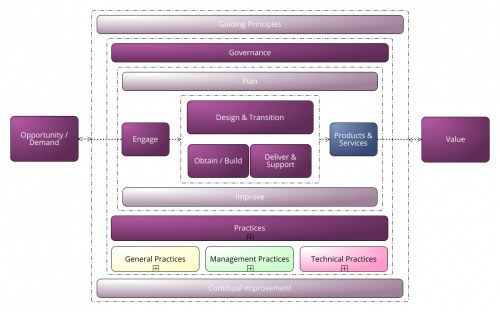
I recently implemented the ITSM Prozessbibliothek deutsch für SAP Signavio digital software into my IT department, and it has revolutionized the way we manage IT services. For years, our ITSM processes relied on a patchwork of outdated documents and tribal knowledge. This led to inefficiencies, inconsistencies, and ultimately, frustrated employees and customers. The ITSM Prozessbibliothek deutsch für SAP Signavio has transformed our approach to ITSM, bringing much-needed structure and clarity to our operations.
Pre-Built Library Saves Time and Ensures Consistency
One of the biggest advantages of this software is the pre-built library of ITSM process templates specific to SAP Signavio. These templates provide a strong foundation for our core IT services, including incident, problem, change, and configuration management. The pre-built nature saved us countless hours compared to building these processes from scratch. Furthermore, the library ensures consistency across all our IT service offerings, eliminating the risk of variations that could lead to confusion or errors.
Visual Process Modelling for Improved Understanding
The software utilizes a visual process modelling approach, which has been a game-changer for our team. Complex workflows are depicted through clear diagrams that showcase the sequence of steps, decision points, and responsible roles. This visual format makes it easy for everyone, regardless of technical expertise, to understand how IT services are delivered. This fosters better collaboration between IT staff and other departments, as everyone has a clear picture of how their requests are handled.
Customization Options for Tailored Processes
While the pre-built library provides a solid starting point, the software also allows for customization. We can easily adapt the templates to reflect our specific IT environment and service offerings. This flexibility ensures that the processes we implement are truly tailored to our unique needs. Additionally, the software allows us to document best practices and service level agreements (SLAs) directly within the process models, providing a central repository for all relevant information.
Integration with SAP Signavio for Seamless Workflow
For organizations already using SAP Signavio, the ITSM Prozessbibliothek offers a seamless integration. The pre-built templates are designed to work flawlessly within the SAP Signavio environment, eliminating the need for data migration or complex integrations. This streamlines the process of implementing and managing ITSM processes, allowing us to leverage the existing capabilities of SAP Signavio.
Enhanced Collaboration and Improved Efficiency
Since implementing the ITSM Prozessbibliothek deutsch für SAP Signavio, we've witnessed a significant improvement in collaboration and efficiency within our IT department. The clear and consistent processes have empowered our staff to handle service requests more effectively. Additionally, the software has facilitated better communication with end-users, as they now have a clear understanding of how IT services are delivered. Overall, this has resulted in a noticeable reduction in service resolution times and a more streamlined IT service experience.
In conclusion, the ITSM Prozessbibliothek deutsch für SAP Signavio is an invaluable tool for any organization looking to streamline their IT service management processes. The combination of pre-built templates, visual process modelling, and SAP Signavio integration makes it a powerful solution for improving efficiency, communication, and overall IT service delivery.pen_sparktunesharemore_vert
Upload an image
This prompt requires an image that you need to add. Tap the image button to upload an image. Got it
Do you need a little help with this prompt?
Power up your prompt and Gemini will expand it to get you better resultsGot it
2 notes
·
View notes
Text
SAP GRC Conference 2024
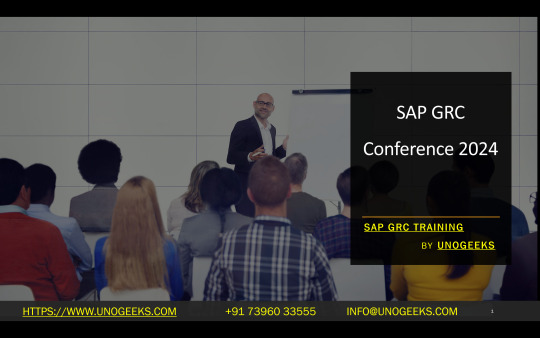
The Future of Integrated GRC: Highlights and Anticipations from the SAP GRC Conference 2024
The SAP GRC Conference 2024 was a resounding success. Held in Brussels, it brought together industry experts, SAP customers, and partners for cutting-edge discussions on Governance, Risk, and Compliance (GRC). This groundbreaking event united the former SAP for Internal Controls, Compliance, and Risk Management and the SAP for Cyber Security and Data Protection conferences, exemplifying the increasing convergence of GRC disciplines.
Key Themes and Takeaways
Business-Integrated GRC: A recurring theme was the need for GRC to become less siloed and more deeply woven into organizational strategy and decision-making. Leaders emphasized that proactive, integrated GRC can create a competitive advantage rather than function as a necessary overhead cost.
Automation and AI: The conference highlighted how automation and artificial intelligence reshape GRC processes. Intelligent tools can take on routine tasks, risk pattern identification, and predictive analytics, freeing GRC professionals to focus on complex issues and strategic planning.
The Evolving Risk Landscape: Discussions centered around the evolving risk landscape in the digital age. Topics like third-party risk, supply chain disruptions, and rapidly changing regulatory frameworks were hotbeds of conversation. The necessity for agile GRC systems that can adapt to these shifting dangers was paramount.
Speaker Insights and Highlights
Michael Rasmussen (GRC 20/20): This GRC thought leader offered a visionary keynote on the future of business-integrated GRC, the role of advanced technologies, and how organizations can leverage GRC for transformation and resilience.
Charlotte Hedemark (FERMA): The newly appointed FERMA President shared perspectives on risk management in the face of recent disruptions, strategies for building risk maturity, and fulfilling board-level expectations.
SAP Leadership: SAP executives unveiled future roadmaps for the SAP GRC suite. They focused on tighter integration across modules, enhanced automation capabilities, and a user-centric approach for better risk insights and reporting.
Beyond the Sessions: Networking and Collaboration
The SAP GRC Conference 2024 thrived on the energy of the GRC community. Networking opportunities allowed for best practice sharing and solution comparisons and sparked potential new partnerships. The vibrant exhibition floor showcased innovative solutions and cutting-edge technologies shaping the future of risk and compliance.
Looking Ahead
The SAP GRC Conference 2024 underscored the pivotal moment GRC finds itself in. The focus is shifting from mere compliance to strategic, value-driven GRC that empowers businesses to tackle new challenges and seize opportunities in a dynamic global landscape. GRC professionals must embrace these themes and drive innovation within our organizations to secure our collective futures.
youtube
You can find more information about SAP GRC in this SAP GRC Link
Conclusion:
Unogeeks is the No.1 IT Training Institute for SAP GRC Training. Anyone Disagree? Please drop in a comment
You can check out our other latest blogs on SAP GRC here – SAP GRC Blogs
You can check out our Best In Class SAP GRC Details here – SAP GRC Training
Follow & Connect with us:
———————————-
For Training inquiries:
Call/Whatsapp: +91 73960 33555
Mail us at: [email protected]
Our Website ➜ https://unogeeks.com
Follow us:
Instagram: https://www.instagram.com/unogeeks
Facebook: https://www.facebook.com/UnogeeksSoftwareTrainingInstitute
Twitter: https://twitter.com/unogeeks
#Unogeeks #training #Unogeekstraining
3 notes
·
View notes
Text
SAP Risk Management | SAP GRC RM | Governance Risk & Compliance | ToggleNow
At ToggleNow, we understand that exhaustive lists of risks can overwhelm and often become irrelevant, leading to inefficiencies. Our approach emphasizes focusing on value and core business activities in risk management. We believe that prioritizing risks impacting value and business performance is crucial, even if it means concentrating on a smaller yet more impactful segment of the business.

Our commitment lies in streamlining risk management efforts by leveraging SAP Risk Management. This comprehensive solution fosters collaboration and ensures consistency throughout your organization. We empower businesses to navigate risks effectively while concentrating efforts where risk managers can make the most significant contributions.
Read more: https://togglenow.com/services/sap-risk-management/
#SAP Risk Management#SAP Risk Management Tool#SAP Risk Management services#SAP Enterprise Risk Management#SAP Risk Management Software#SAP Governance Risk and Compliance#SAP GRC Solutions Provider
0 notes
Text
5 Hidden SAP GRC Pitfalls That Could Jeopardize Your Compliance Strategy
1. “One-Size-Fits-All” RuleSet Syndrome
Many organizations implement SAP GRC with out-of-the-box rule sets and assume they’re covered and are completely Sox/SoD compliant. The problem? Standard rule sets don’t always reflect the unique business processes and risks of an enterprise. They must be utilized as a baseline.
Example: A global company using a generic SoD rule set might flag conflicts that aren’t actually risks in their specific operations, leading to unnecessary firefighting and role redesign efforts.
What is the solution? It is always recommended to tailor the rule set to align with your business needs. Involve process owners and auditors to ensure relevance. Disable those which are not relevant and add the ones what needs to be part of the rule set. For example, your custom transaction codes.
2. Over-Reliance on Automated Controls
Yes, automation is powerful, but blindly trusting automated GRC controls without proper oversight is a recipe for disaster.
Example: Automated access reviews might seem great, but if managers are just clicking the approval button without understanding the risk, you’re inviting compliance issues.
What is the solution? Combine automation with human intelligence. Train reviewers on what they’re approving and implement periodic audits.
3. The “Too Many Firefighters” Problem
Firefighter (emergency access) access is meant for temporary, critical access. But in many companies, they become a backdoor for permanent privileged access. I’ve seen in some instances where the FFIDs have SAP_ALL, SAP_NEW assigned
Example: If every second user has firefighter access “just in case,” then what’s really being controlled?
What is the solution? Reduce firefighter usage with strict policies. Ensure that the Firefighter IDs have limited and relevant access, not SAP_ALL. Look at how often your users are asking for such access. Set expiration dates, and enforce approvals before access is granted. A detailed review is must after the usage.
4. Role Design Nightmares
Ever seen a single SAP role with 500+ transaction codes? It happens more often than you’d think. Poorly designed roles create access chaos, security risks, and audit nightmares.
Example: A company that grants “Display All” access thinking it’s harmless—only to realize some reports contain sensitive payroll data.
What is the solution? Follow a least privilege approach. Display tcodes does possess risks. Design roles based on business functions, not user demands and assumptions. And, no, giving everyone SAP_ALL is not a solution!
5. The “Check-the-Box” Compliance Trap
Many organizations treat GRC as a compliance checklist rather than a risk mitigation strategy. The result? A false sense of security.
Example: An enterprise that passes an audit but later discovers a critical access loophole exploited by an insider threat.
What is the solution? Shift from a compliance-first mindset to a risk-first approach. Ask, “What’s the real-world impact of this control?” rather than just checking off audit items.
Final Thoughts: GRC is Not Just About Tools, It’s About Mindset
SAP GRC isn’t just about implementing Access Control, Process Control, or Risk Management modules—it’s about adopting a security and compliance culture. The best GRC strategies combine technology, process rigor, and human intelligence to create a resilient, risk-aware organization.
Readmore: https://togglenow.com/blog/sap-grc-hidden-pitfalls/

#SAP Risk Management#SAP access risk analysis tool#SAP GRC access control solution#SAP segregation of duties automation#SoD risk analysis for SAP
0 notes
Text
B2B Database Contacts: Achieving the Precise Harmony Between Quality and Quantity
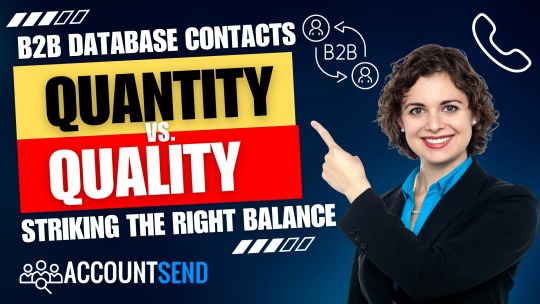
In the ever-evolving landscape of B2B sales, the tapestry of effective B2B Lead Generation, targeted Sales Leads, and strategic Business Development is intricately woven with the threads of the B2B Contact Database. This comprehensive article embarks on an exploration to unravel the profound interplay between quality and quantity – the pulse that resonates within B2B Database Leads. Join us on this journey as we traverse the pathways, strategies, and insights that guide you towards mastering the equilibrium, steering your Sales Prospecting initiatives towards finesse and success.
DOWNLOAD THE INFOGRAPHIC HERE
The Essence of Quality
Quality emerges as the cornerstone in the realm of B2B Lead Generation, encapsulating the essence of depth, precision, and pertinence that envelops the contact data nestled within the B2B Contact Database. These quality leads, much like jewels in a treasure trove, possess the capacity to metamorphose into valuable clients, etching a definitive impact on your revenue stream. Every contact entry isn't a mere data point; it's a capsule that encapsulates an individual's journey – their role, industry, buying tendencies, and distinctive preferences. Cultivating a repository of such high-caliber contacts is akin to nurturing a reservoir of prospects, where each interaction holds the promise of meaningful outcomes.
Deciphering the Role of Quantity
Yet, even in the pursuit of quality, quantity emerges as a steadfast ally. Quantity embodies the expanse of contacts that populate your B2B Database Leads. Imagine casting a net wide enough to enfold diverse prospects, broadening your scope of engagement. A higher count of contacts translates to an amplified potential for interaction, heightening the probability of uncovering those latent prospects whose untapped potential can blossom into prosperous business alliances. However, it's imperative to acknowledge that quantity, devoid of quality, risks transforming into an exercise in futility – a drain on resources without yielding substantial outcomes.
Quality vs. Quantity: The Artful Balancing Act
In the fervor of database compilation, the allure of sheer quantity can occasionally overshadow the crux of strategic B2B Sales and Sales Prospecting. An extensive, indiscriminate list of contacts can rapidly devolve into a resource drain, sapping efforts and diluting the efficacy of your marketing endeavors. Conversely, an overemphasis on quality might inadvertently curtail your outreach, constraining the potential for growth. The true artistry lies in achieving a symphony – a realization that true success unfolds from the harmonious interaction of quality and quantity.
youtube
Navigating the Equilibrium
This path towards equilibrium demands a continual commitment to vigilance and meticulous recalibration. Consistent audits of your B2B Contact Database serve as the bedrock for maintaining data that is not only up-to-date but also actionable. Removing outdated, duplicated, or erroneous entries becomes a proactive stride towards upholding quality. Simultaneously, infusing your database with fresh, relevant contacts injects vibrancy into your outreach endeavors, widening the avenues for engagement and exploration.
Harnessing Technology for Exemplary Data Management
In this era of technological prowess, an array of tools stands ready to facilitate the intricate choreography between quality and quantity. Step forward Customer Relationship Management (CRM) software – an invaluable ally empowered with features such as data validation, deduplication, and enrichment. Automation, the pinnacle of technological innovation, elevates database management to unparalleled heights of precision, scalability, and efficiency. Embracing these technological marvels forms the bedrock of your B2B Sales and Business Development strategies.
Collaborating with Esteemed B2B Data Providers
In your pursuit of B2B Database Leads, consider forging collaborations with esteemed B2B data providers. These seasoned professionals unlock a treasure trove of verified leads, tailor-made solutions for niche industries, and a portal to global business expansion. By tapping into their expertise, you merge the realms of quality and quantity, securing a comprehensive toolkit poised to reshape your sales landscape.
As we draw the curtains on this exploration, remember that the compass steering your B2B Sales, Sales Prospecting, and Business Development endeavors is calibrated by the delicate interplay of quality and quantity. A B2B Contact Database enriched with high-value leads, accompanied by a robust quantity, stands as the axis upon which your strategic maneuvers pivot. Equipped with insights, tools, and allies like AccountSend, your pursuit to strike this harmonious equilibrium transforms into an enlightening journey that propels your business towards enduring growth and undeniable success.
#AccountSend#B2BLeadGeneration#B2B#LeadGeneration#B2BSales#SalesLeads#B2BDatabases#BusinessDevelopment#SalesFunnel#SalesProspecting#BusinessOwner#Youtube
14 notes
·
View notes
Text
The Collaboration of Clinical Data Management and Biostatistics in Evidence-Based Medicine
Introduction:
In the realm of clinical research, the seamless collaboration between clinical data management (CDM) and biostatistics is paramount for ensuring the accuracy, reliability, and integrity of study outcomes. This dynamic partnership plays a pivotal role in transforming raw data into meaningful insights that drive evidence-based medical decisions. In this blog post, we delve into the essential interactions between CDM and biostatistics, highlighting their respective contributions and synergies in the clinical research landscape.

Data Collection and Database Design:
CDM professionals are responsible for designing robust data collection tools and establishing comprehensive data management plans.
Biostatisticians collaborate closely to ensure that data collection instruments capture relevant variables with precision, enabling accurate statistical analysis.
Joint efforts streamline the development of databases that adhere to regulatory standards and facilitate efficient data entry, validation, and cleaning processes.
Data Quality Assurance:
CDM specialists implement quality control measures to identify and address data discrepancies, inconsistencies, and errors.
Biostatisticians contribute expertise in data validation and verification, conducting thorough checks to maintain data integrity.
Continuous communication between CDM and biostatistics teams fosters proactive identification and resolution of data quality issues, enhancing the reliability of study findings.
Statistical Analysis Planning:
Biostatisticians from Biostatistics Services collaborate with CDM professionals to formulate robust statistical analysis plans (SAPs) tailored to study objectives and design.
CDM experts provide insights into data structure, collection processes, and potential biases, informing statistical modeling approaches and hypotheses testing strategies.
The synergy between CDM and biostatistics ensures that analytical methodologies align with data characteristics, maximizing the validity and interpretability of study results.
Data Interpretation and Reporting:
Biostatisticians play a pivotal role in analyzing study data, interpreting statistical findings, and deriving meaningful conclusions.
CDM specialists assist in contextualizing statistical results within the broader clinical framework, elucidating the implications for patient care and treatment strategies.
Collaborative review and refinement of study reports and publications ensure accurate representation of data insights and statistical significance.
Regulatory Compliance and Audits:
CDM professionals and biostatisticians collaborate to ensure compliance with regulatory requirements and industry standards governing data management and statistical analysis.
Joint efforts facilitate preparation for regulatory inspections and audits, with comprehensive documentation and audit trails supporting data integrity and traceability.
Continuous monitoring and adherence to regulatory updates and guidelines mitigate risks and enhance the credibility of clinical research outcomes.
Conclusion:
The intricate interplay between clinical data management services and biostatistics underscores the importance of collaborative synergy in advancing evidence-based medicine. By leveraging their respective expertise and working in tandem throughout the research lifecycle, CDM and biostatistics teams synergize efforts to uphold data quality, integrity, and regulatory compliance. Clinical data management services, such as those provided by Global Pharma Tek, play a crucial role in designing robust data collection tools, establishing comprehensive data management plans, and implementing quality control measures to ensure the accuracy and reliability of study data. This harmonious partnership not only drives scientific discovery and innovation but also contributes to improved patient outcomes and healthcare decision-making.
2 notes
·
View notes
Text
SAP EHS Tutorial for Beginners
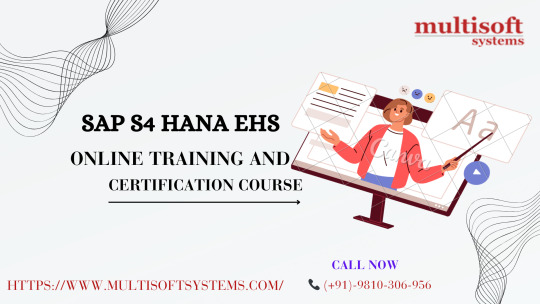
SAP EHS (Environment, Health, and Safety) represents a significant leap forward for organizations aiming to prioritize sustainability and ensure the safety and well-being of their workforce while adhering to environmental regulations. This comprehensive solution integrates seamlessly with other SAP modules, offering a centralized platform for managing a wide range of EHS tasks.
At its core, SAP EHS training by Multisoft Systems is a module within the broader SAP ERP system designed to help businesses manage their environmental, health, and safety obligations more effectively. It enables companies to track and reduce emissions, manage chemicals safely, ensure workplace safety, and comply with global and local environmental, health, and safety regulations. By automating and streamlining EHS processes, SAP EHS not only helps companies meet legal standards but also promotes a culture of safety and environmental responsibility.
Key Features
Compliance Management: SAP EHS simplifies the complexity of complying with regulatory requirements by providing tools to monitor and manage compliance tasks across different jurisdictions.
Hazardous Substance Management: It offers comprehensive capabilities to manage hazardous substances, including inventory tracking, safety data sheet management, and regulatory reporting, ensuring safe handling and storage.
Occupational Health: This feature focuses on protecting employees’ health by monitoring workplace hazards, managing medical checks, and tracking health indicators over time.
Safety Measures and Risk Management: SAP EHS facilitates the identification, evaluation, and mitigation of risks associated with workplace safety and environmental hazards, helping to prevent accidents and incidents.
Waste Management: It provides tools for managing waste disposal processes, including waste classification, transportation, and disposal documentation, aiding in sustainable waste management practices.
Environmental Management: This encompasses monitoring and reporting on air emissions, water discharges, and energy use, supporting efforts to reduce an organization’s environmental footprint.
Benefits of Using SAP EHS
Enhanced Compliance: With SAP EHS, companies can stay ahead of regulatory changes and ensure compliance with environmental, health, and safety standards, reducing the risk of legal issues and penalties.
Risk Reduction: By proactively managing hazards and risks, SAP EHS helps reduce the potential for workplace accidents and environmental incidents, safeguarding employees and the environment.
Operational Efficiency: Automating and centralizing EHS processes leads to significant improvements in operational efficiency, enabling companies to manage EHS tasks more effectively and with fewer resources.
Sustainability Promotion: SAP EHS supports sustainable business practices by enabling companies to monitor and reduce their environmental impact, aligning with global sustainability goals and improving corporate image.
Data-Driven Decision Making: The unified platform aggregates data from various sources, providing valuable insights that help in making informed decisions regarding EHS initiatives and improvements.
Functionalities
The SAP EHS (Environment, Health, and Safety) system is equipped with a suite of functionalities designed to address the comprehensive needs of businesses in maintaining a safe, healthy, and environmentally responsible operation. Here's a closer look at these functionalities and how they support enterprises in achieving their EHS goals:
1. Employee Health and Safety Functionality
This functionality is foundational to fostering a safe work environment and promoting employee well-being. It encompasses a range of tools for hazard identification, risk assessment, incident management, and health surveillance. With these capabilities, companies can proactively manage workplace risks, comply with occupational health and safety regulations, and implement preventive measures to reduce the incidence of workplace injuries and illnesses. Features like injury and illness reporting, safety training management, and health monitoring are integral to maintaining a culture of safety and health within the organization.
2. Product Safety Functionality
Ensuring product safety is paramount in today’s regulatory environment. SAP EHS's Product Safety functionality helps organizations manage the safety aspects of their products across the entire lifecycle, from design and production to distribution and disposal. This includes managing Safety Data Sheets (SDS), ensuring proper labeling and packaging, and conducting safety assessments. By enabling compliance with global and local product safety regulations, this functionality helps businesses protect consumers, avoid legal and financial penalties, and maintain their reputation in the market.
3. Environmental Compliance Management Functionality
Environmental compliance management is critical for businesses looking to adhere to environmental laws and regulations, such as emissions reporting, waste management, and water quality standards. SAP EHS provides tools for tracking environmental impacts, managing permits and reporting requirements, and conducting audits and inspections. This functionality supports businesses in their efforts to minimize their environmental footprint, manage waste responsibly, and ensure continuous compliance with evolving environmental regulations.
4. Product and REACH Compliance Functionality
Product compliance is essential for navigating the complex landscape of global trade and market access requirements. This includes managing substances, ensuring compliance with regulations like REACH (Registration, Evaluation, Authorization, and Restriction of Chemicals), and maintaining product documentation and certifications. SAP EHS’s Product and REACH Compliance functionalities offer a robust framework for managing these requirements, facilitating compliance with substance regulations, and ensuring that products meet the necessary safety and environmental standards before they reach the market.
What skills will you learn?
Understanding and leveraging specific tools, software, or methodologies relevant to your field.
The ability to analyze situations, identify problems, and develop logical solutions.
Effective verbal and written communication skills, including the ability to present information clearly and persuasively.
Skills in organizing, planning, and executing projects to meet objectives within constraints of time, budget, and scope.
The capability to collect, process, and interpret data to inform decisions.
Leading teams effectively, motivating others, and managing conflicts.
The ability to adjust to new conditions, technologies, and challenges quickly.
Conclusion
SAP EHS online training by Multisoft Systems stands as a testament to SAP's commitment to supporting organizations in their environmental, health, and safety efforts. As businesses increasingly recognize the importance of sustainable practices and workplace safety, SAP EHS emerges as an essential tool for managing these critical aspects effectively. By leveraging SAP EHS, companies can not only ensure compliance and reduce risks but also contribute positively to their community and the environment, paving the way for a more sustainable future.
1 note
·
View note
Text
The Crucial ERP System Examples: Transforming Business Operations

In today’s fiercely competitive business realm, the quest for operational efficiency and streamlined management is paramount. Enterprise Resource Planning (ERP) systems stand tall as technological marvels, revolutionizing the way businesses operate. These robust software solutions amalgamate various functions within a unified framework, enabling seamless coordination across departments and facilitating data-driven decision-making.
This exploration ventures into the realm of ERP systems, shedding light on a spectrum of exemplary solutions that have reshaped modern business operations. From stalwarts like SAP ERP and Oracle ERP Cloud to innovative players like Microsoft Dynamics 365 and Odoo, each system represents a unique amalgamation of features, functionalities, and industry applications.
This comprehensive journey traverses the functionalities, industry adaptability, and transformative potentials of these ERP systems. Understanding their intricacies is pivotal for businesses seeking to optimize processes, unlock efficiencies, and navigate the complexities of today’s business landscape. Join this insightful exploration to unravel the significance and impact of these ERP system examples in shaping the future of business operations.
ERP System Examples
1. SAP ERP: Revolutionizing Business Management
SAP ERP has solidified its position as a leader by providing an all-encompassing suite covering critical business functions. Beyond its core modules in finance, HR, and supply chain, SAP offers specialized applications for industry-specific needs. For instance, SAP S/4HANA, an intelligent ERP, integrates AI and analytics for real-time insights, empowering businesses to adapt swiftly to market changes.
The scalability of SAP ERP is noteworthy, catering to startups aiming for growth and global corporations managing complex operations. It provides modular solutions, enabling businesses to adopt specific functionalities based on their immediate needs.
2. Oracle ERP Cloud: Innovating Operations in the Cloud
Oracle ERP Cloud’s robust suite extends far beyond traditional ERP capabilities. It embraces emerging technologies like AI, machine learning, and blockchain to drive innovation. Its predictive analytics empower businesses to anticipate market trends, optimize supply chains, and mitigate risks effectively.
The cloud-based structure of Oracle ERP Cloud ensures not just accessibility but also scalability without compromising security. It enables seamless integration with other Oracle Cloud applications, fostering a unified ecosystem for comprehensive business management.
3. Microsoft Dynamics 365: Integrating CRM and ERP Capabilities
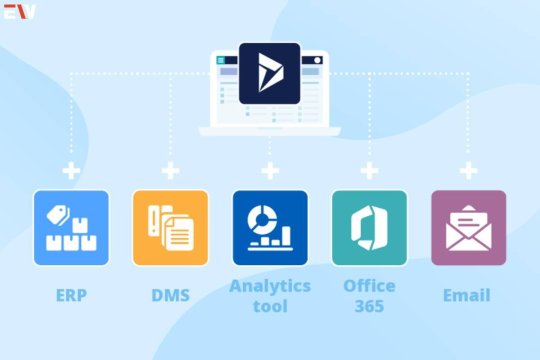
Microsoft Dynamics 365 is a fusion of CRM and ERP functionalities, providing a holistic platform for businesses. Unlike its core ERP modules, Dynamics 365 offers advanced tools for customer engagement, field service, and marketing automation. Its flexibility lies in its modularity, allowing businesses to tailor their systems by choosing specific applications that align with their objectives.
Moreover, its integration with Microsoft Office 365 and Power Platform strengthens collaboration and data analysis, facilitating informed decision-making across departments.
4. NetSuite: Empowering Diverse Industries
NetSuite’s cloud-based ERP system addresses the complex needs of various industries. Its suite encompasses solutions for financial management, e-commerce, and inventory control. Beyond the core ERP functionalities, NetSuite offers industry-specific modules, such as SuiteCommerce for retail businesses and SuiteSuccess for services, enhancing its appeal across diverse sectors.
The scalability and adaptability of NetSuite make it a preferred choice for businesses experiencing rapid growth or seeking to expand into new markets.
5. Infor ERP: Tailored Solutions for Specific Sectors
Infor’s industry-specific ERP solutions cater to the nuanced requirements of sectors like healthcare, manufacturing, and distribution. In addition to its standard ERP functionalities, Infor focuses on specialized applications such as Infor CloudSuite Healthcare for healthcare organizations and Infor LN for manufacturing, ensuring tailored solutions for sector-specific challenges.
Infor’s commitment to innovation and addressing sector-specific complexities underscores its relevance in the ERP landscape.
6. Epicor ERP: Amplifying Industry Operations
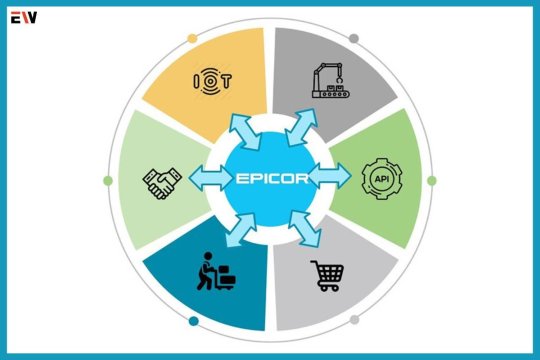
Epicor ERP excels in catering to industries such as manufacturing, distribution, retail, and services. Its core ERP functionalities are complemented by advanced analytics and business intelligence tools. Epicor’s Smart Inventory Planning and Optimization (IPO) tool, for instance, utilizes AI to enhance inventory management, improving efficiency and reducing costs.
Moreover, its agile architecture enables easy customization and integration with third-party applications, providing businesses with a highly adaptable solution.
7. Odoo: Flexibility and Customization
Odoo’s open-source ERP system offers an extensive suite of applications covering CRM, inventory management, project management, and more. What sets Odoo apart is its modular nature, allowing businesses to select and integrate specific applications as per their requirements. Odoo’s flexibility and affordability are especially beneficial for small to medium-sized enterprises seeking customizable solutions without exorbitant costs.
The Value of ERP Systems in Modern Business
ERP systems serve as catalysts for efficiency, productivity, and growth:
Streamlined Operations: Automating tasks streamlines processes, reducing manual errors and optimizing resource allocation.
Enhanced Data Management: Centralized databases ensure data consistency and accuracy, fostering informed decision-making.
Agile Decision-Making: Real-time data access empowers businesses to make agile decisions, staying ahead in dynamic markets.
Customer-Centric Approach: Integrated CRM functionalities enable businesses to deliver personalized services, boosting customer satisfaction and loyalty.
Making Informed Choices: Selecting the Right ERP System

The process of choosing an ERP system involves careful evaluation and alignment with a business’s unique needs. Understanding the scalability, integration capabilities, and industry-specific functionalities of each system is crucial for successful adoption.
Conclusion: Embracing ERP Systems for Sustainable Growth
The landscape of ERP systems continues to evolve, offering businesses versatile solutions to streamline operations, enhance efficiency, and foster sustainable growth. From SAP’s scalability to Oracle’s cloud-driven innovation and Odoo’s customization prowess, each system exemplifies the diverse capabilities shaping modern business management.
Selecting the right ERP system aligned with specific needs remains pivotal for organizations seeking resilience and competitiveness. As businesses strive for optimization and adaptability, embracing these transformative technologies ensures a strategic advantage in an ever-evolving market. It stands as a pillar of efficiency, empowering businesses to navigate complexities and drive success through informed decisions and streamlined operations.
Also Read: A Deep Dive into Corporate Wellness Programs for a Healthier, Happier Workplace
#ERPRevolution#BusinessTransformation#TechInnovation#DigitalTransformation#EnterpriseSolutions#InnovationInBusiness#TechLeadership
2 notes
·
View notes
Text
Career Paths for SAP S/4 HANA FI Certified Professionals
In today's rapidly evolving business landscape, organizations need to leverage data and technology to stay competitive. One of the key players in this arena is SAP, a global leader in enterprise software solutions. SAP's S/4 HANA Financial Accounting (FI) module has become integral to the operations of countless organizations, making certified professionals in this field highly sought after.
If you're considering a career in SAP S/4 HANA FI, you'll be pleased to know that there are numerous career paths open to you. In this article, we'll explore nine exciting career options for SAP S/4 HANA FI certified professionals.Before we get into these job choices, Finprov Learning is a reliable platform that offers high-quality SAP training and certification programs. Finprov Learning can help you succeed in this industry and obtain your needed skills.
Careers in SAP S/4 HANA FI
SAP S/4 HANA FI Consultant
To implement, adapt, and improve your client's financial accounting systems, you will collaborate closely with them as a SAP S/4 HANA FI consultant. This position includes reviewing business procedures, setting up SAP systems, and offering continuous assistance and training.
Financial Analyst
S/4 HANA SAP Professionals with FI certification are well-suited for employment as financial analysts. They can use their knowledge of SAP systems to analyze financial data, provide reports, and offer insights to help organizations make better decisions.
SAP S/4 HANA FI Project Manager
In SAP implementations, project management is essential. Strong communicators and project managers who are SAP S/4 HANA FI certified may successfully oversee the planning and implementation of SAP projects.
SAP S/4 HANA FI System Administrator
SAP systems need to be maintained and troubleshot by system administrators. You can operate as a system administrator, ensuring the efficient operation of financial modules and resolving any technical issues if you have certification in SAP S/4 HANA FI.
SAP S/4 HANA FI Trainer
If you enjoy teaching and are passionate about SAP, consider becoming an SAP S/4 HANA FI trainer. Many organizations require in-house employee training, and your expertise can be invaluable in this role.
SAP S/4 HANA FI Data Analyst
Data analytics is a growing field, and SAP S/4 HANA FI-certified professionals can apply their skills to extract valuable insights from financial data. This career path involves using tools like SAP Analytics Cloud to analyze and visualize financial information.
SAP S/4 HANA FI Auditor
Financial audits are a crucial part of any business. SAP S/4 HANA FI certified professionals can work as auditors, ensuring financial compliance, risk management, and fraud detection within organizations.
SAP S/4 HANA FI Solution Architect
Solution architects design and plan the implementation of SAP solutions, ensuring they align with business objectives. With certification in SAP S/4 HANA FI, you can become a solution architect, shaping the financial systems of the future.
SAP S/4 HANA FI Business Analyst
Business analysts bridge the gap between technical SAP knowledge and business processes. They evaluate how SAP solutions can meet specific business needs and work on improving financial processes.
Conclusion
The certified SAP S/4 HANA FI professional opens doors to numerous exciting and financially rewarding opportunities. Whether you're inclined to work closely with clients, delve into data analysis, or manage projects, there's a career path tailored to your unique skills and interests. The demand for SAP S/4 HANA FI experts is on a consistent rise, cementing it as a prudent choice for those seeking success in the dynamic realm of finance and technology. And if you're contemplating a career in this field, rest assured that the possibilities are extensive, and the future looks promising. To kickstart your SAP S/4 HANA FI journey, consider Finprov Learning, where you'll find top-notch resources and guidance to excel in this flourishing domain. With Finprov Learning, your career possibilities in SAP S/4 HANA FI are bound to expand.
2 notes
·
View notes
Text
Importance of Internal Audits
Internal audits are essential for assessing an organization's operations, identifying risks, ensuring compliance with regulations, and improving overall efficiency. They provide insights into financial, operational, and compliance-related aspects of your business.
Why Use Software for Internal Audits?
Efficiency: Software automates many audit processes, reducing the time and effort required to conduct audits.
Accuracy: Manual audits can be error-prone. Audit software helps ensure accuracy in data collection and analysis.
Consistency: Software enforces consistent audit procedures and documentation across your organization.
Real-time Reporting: With audit software, you can generate real-time reports, making it easier to track progress and address issues promptly.
Data Security: Audit software enhances data security, protecting sensitive information from unauthorized access.
Top Software Solutions for Internal Audits
ACL GRC: ACL GRC offers a comprehensive solution for internal audits, including risk assessment, data analysis, and reporting. It's known for its user-friendly interface and robust analytics.
TeamMate+: TeamMate+ is a widely used audit management software that streamlines the entire audit process, from planning to reporting. It offers customizable templates and powerful reporting tools.
AuditBoard: AuditBoard is a cloud-based platform that provides tools for risk assessment, audit management, and compliance. Its user-friendly interface makes it accessible to auditors at all levels.
Wolters Kluwer TeamMate Analytics: This software focuses on data analytics, helping auditors identify trends and anomalies in data. It integrates seamlessly with other audit management systems.
SAP Audit Management: If your organization uses SAP, their Audit Management software is a natural choice. It offers a unified platform for audit planning, execution, and reporting.
Conclusion
In today's fast-paced business environment, efficient and accurate internal audits are crucial for staying competitive and compliant. Investing in audit software can streamline your audit processes, improve accuracy, and provide valuable insights for decision-making. Evaluate your organization's needs and explore the options mentioned above to find the best software for doing internal audits that align with your goals and objectives.
For more details - https://m2iconsulting.com/blog-detail.php?name=Software%20for%20Doing%20Internal%20Audit&id=64
2 notes
·
View notes